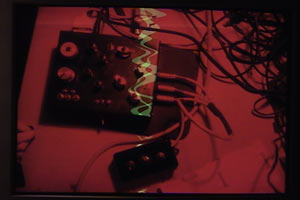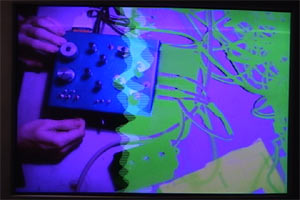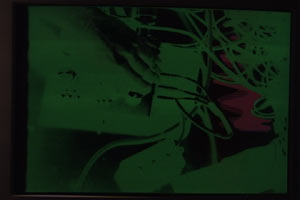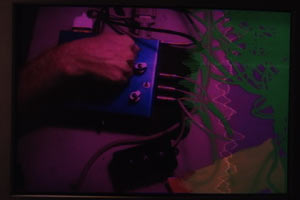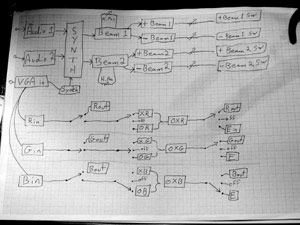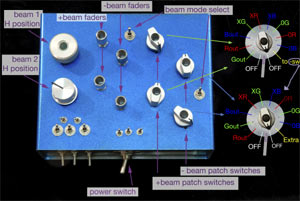VS001 - VGA Expropriator
Analogue Video Synthesizer
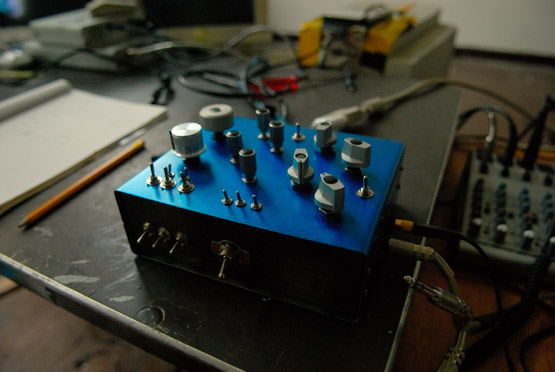
Main Attributes:
- 2 audio inputs
- 2 VGA inputs
- 1 VGA output
- 25 pin proprietary D-Sub connector with extra connections for RGB, sync, +5V, and 2 CV inputs.
- individual effects loop inserts (send/return) for R,G, and B video channels
- 18 switches, 4 faders, and 2 wipe controls for a wide variety of signal routing and mixing options
- buss powered
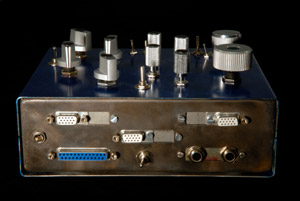
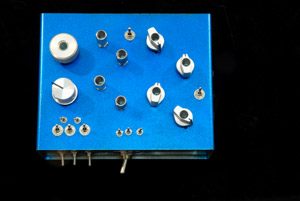
back panel and top views
Video synthesis tends to be dominated by digital technology these days however analogue video synthesis techniques can still offer a great many advantages in terms of aesthetics, performance, simplicity, and adaptability. Not to mention the non-linear surprises which can come from working in the analogue domain. This "VGA Expropriator" will be the first in a series of proprietary analogue hardware devices which seek to explore the possibilities of digital/analogue hybrid technology in video/audio performance and studio production contexts. The first offering here is essentially a new design with its creative process making ample use of circuit-bending methodologies.
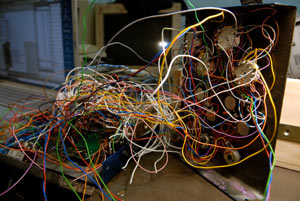
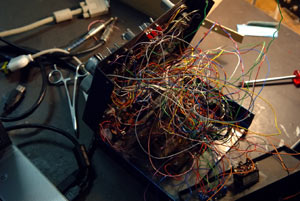
interior views
The main function of this device is to synthesize 2 audio inputs with a VGA input allowing audio waveforms to be viewed on a computer display. The results are very much like that of a dual-trace oscilloscope with vertical rather than horizontal beams. Internal patches can be used to combine the beams in a wide variety of ways making for a great many imagery possibilities.
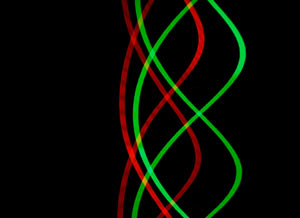
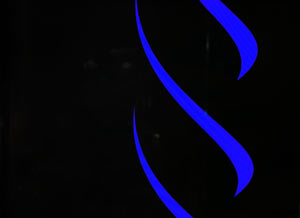
50Hz tone with different patches
By synching to a VGA input from a computer, the unit will function at any resolution and refresh-rate supported by both computer and display device. This has been tested on a LCD video projector up to 2048x1538 @ 60Hz and 800x600 @ 120Hz with good results. It can make for a lot of depth in terms of visualizing the character and subtle nuances of an audio input. Since vertical refresh rate translates to frames/second, (though I'm not totally sure about how to test this) 100Hz makes for 100 unique frames per second with this system resulting in very smooth and fluid motion. What's more, this realtime depth and speed comes without any digital process lag.
Each audio trace-beam's horizontal position on the screen can be adjusted with individual potentiometers, also allowing for audio sensitivity to be adjusted. 4 more pots allow the positive and negative image intensity of each beam to be varied. These 4 pots each have their own 12 position rotary switch which routes the signal to the Red, Green, or Blue output channels or a number of other internal mixing points. Each beam also has a mode selector switch which increases the number of image mixing possibilities.
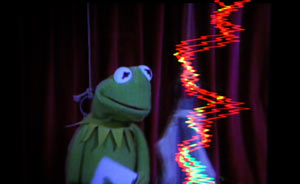
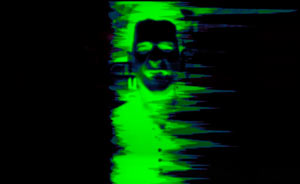
audio input mixed into computer's VGA output
Images from the computer can be passed straight through to the display unaltered or mixed with the audio beam traces in various ways with individual banks of switches for each colour component. Besides the basic superimposition of the beams on top of a video, internal patches allow for the edge of an audio beam to provide split-screen 'wipes' and for some kinds of crude keying effects to occur.
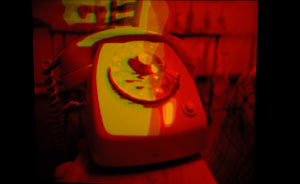
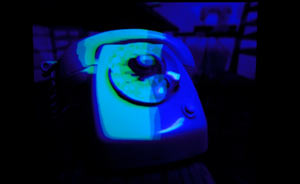
audio beam keyed into brighter parts of image
3 switched TRS-jacks on the side of the case function as effects loop inserts, one for each colour component. Effects in the form of a breakout-box may include a simple colour mixer, individual faders for each colour [see VS002], filters, or even the use of ordinary audio equipment to alter the video. The limited bandwidth of most audio gear tends strip the detail from the image and can actually make for some nice organic blobs of shape and colour. Some initial experiments routed one, two, or all three colour components through an audio mixer which was also supplying sound to the beam generators resulting in some crazy feedback loops.
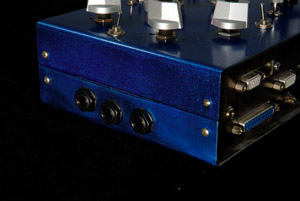
effects loop insert jacks
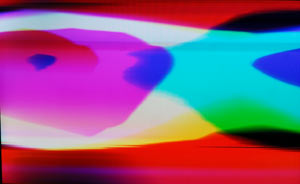
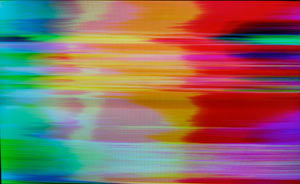
video components bypassed through an analogue audio mixer and looped back into beam generators
In the interests of solid construction, an old printer-data-switch box was used for the case. One of the 25-pin D-sub printer ports was preserved and is connected to points on the new circuit with modular expandability in mind. A breakout box connected to the 'printer port' could provide extra audio, RGB and H-V synch inputs or outputs and the possibility of control-voltage inputs. Such a module could also be fed into the main-unit's second VGA input for adding an extra level of effects, more signal generators, feedback loops, and things like that.
The unit's power is selectable between the +5Volts included on pin-9 of a computer's VGA output or from an external +5Volt power supply if needed. This "buss-power" also works with the DVI to VGA connector that comes with G4 laptops (at least with the one tested anyway). All of the VGA ID pins are passed directly through from the input to the output, though most of these don't seem to be a necessity from what I've seen.
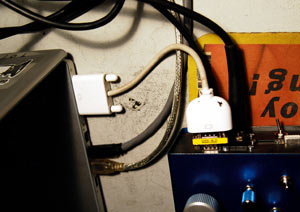
G4 laptop connected to main VGA input providing power and sync
The 2 VGA inputs have a selector switch in order to choose which one will supply the sync. Each VGA input is wired slightly different just to offer a bit of choice in the face of any unforeseen compatibility issues. Mixing the video of 2 computers in the conventional sense is not possible because it would require some kind of time-base correctors or method of syncing multiple computer graphics cards to each other. If 2 computers are connected the result will be nothing more than a bit of extra noise pattern in the image. This could prove to be useful but unsynched signals tend to be a more faint and without much of any movement. Some experiments in playing around with the internal patches did produce a little bit of moving noise which was a bit subtle and consistent.
So far, this video synthesizer has been tested on 3 different CRT monitors, namely an Eizo and 2 different Apple screens. Testing all the different resolution and refresh rate possibilities showed that different sync modes tend to all have a bit their own character and some will react kind of 'backwards' to patches from the synth, presumably because of inverted V synch requirements. 2 LCD video projectors were tested with differing results. One very old LCD beamer from a company called "InFocus" couldn't handle the video due to some sort of built-in image adjustment circuit which couldn't be disabled and would blank the screen in the face of any challenging content. A newer (but still pretty old) LCD video projector from Mitsubishi had no problems and functioned perfectly at every resolution it should support.
update: I have recently checked with 3 different kinds of "conference-series" projectors from Sharp (at least some of them were DLP), a large professional Panasonic projector, a small "note-vision" from Sharp, a medium sized Phillips LCD projector, and a really cheapo Sanyo beamer. All of them worked fine and didn't crap-out, even with mega-glitchy content and changes.
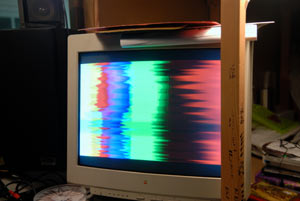
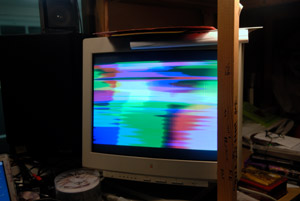
running through an Apple Multiscan 20 Display at 1920x1080 resolution
Screenshots
Just made with a still camera pointed at the screen. No fancy VGA capture gear here (not yet anyway).
High-rez files are included here also.
video files
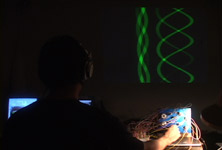 |
Compilation of some initial experiments.
a few cuts are reiterated in following clips as well.
| 6:36min
38.5MB
|
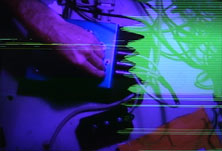 |
Quick overview of various ways of mixing a live video feed with synthesized wave-forms from audio inputs. Live camera is firewire input via GridPro. Music input is 竹村延和 / nobukazu takemura.
This file is sped up.
Normal speed version (75MB, 14:00min) is here
and makes much more sense than the fast one actually.
| 3:37min
40.4MB
|
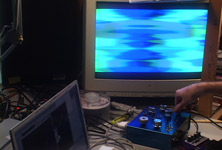 |
Using 2 of the 3 colour-component effects-loop insert-jacks to interface with an analogue audio mixer and delay pedal.
Video signals are routed back into the vidi-synth from the audio mixer, creating more movement on the screen and resulting in a kind of image-movement-audio-movement-image-etc feedback situation.
Video input (with some audio) from computer was taped at a live RUINS concert.
shorter clip of this is in the compilation video above.
| 7:40min
48.1MB
|
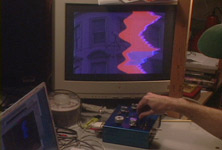 |
Audio input from an analogue synthesizer.
Wave-forms from real instruments tend to look much better than sounds from radio, CDs, etc. Dynamic compression makes things more "flat" looking.
| 1:21min
4.6MB
|
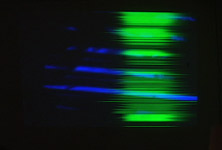 |
2 computers plugged into VS001. The blue patterns come from the computer which is out of sync with the rest.
Sound input is Doof Goblin.
| 0:24min
2.8MB
|
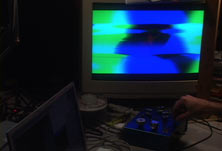 |
Another (rather long and unedited) example of looping video through an audio mixer. Audio pan controls are used to mix colours. Hi, mid, low eqs influence the shape and position of video.
many audio/video feedback glitches and patterns are possible with this technique.
| 12:45min
48.3MB
|
|
Diagrams
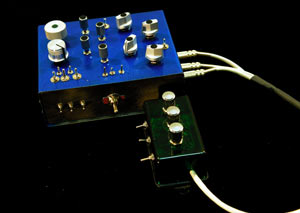
home


















